The system is filled with ethylene glycol based liquid (antifreeze), not freezing at ambient temperatures down to -40°C.
NOTE: The procedure for replacing the coolant is described in subsection «Coolant replacement», With. 101.
WARNINGS: It is not recommended to fill the cooling system with water, as antifreeze contains anti-corrosion, anti-foam and anti-scale additives.
Coolant is toxic! Avoid inhalation of vapors and contact with skin. Timely eliminate the violation of the tightness of the cooling system in order to avoid the ingress of coolant vapor into the vehicle interior during its operation. Your health is more valuable than a new cooling system pipe or a tube of sealant!
The normal thermal regime of the engine is determined by the temperature of the coolant, which is maintained automatically by a thermostat in the range of 90-100°C.
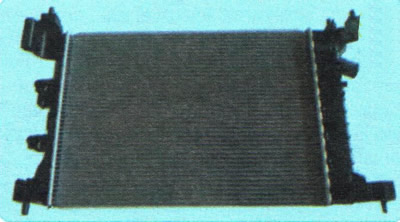
Radiator with a horizontal liquid flow, with a tubular-tape aluminum core and plastic tanks. At the bottom of the right tank is a drain cock. In the radiator tanks there are inlet and outlet pipes of hoses to the engine water jacket, as well as a hose pipe connecting the radiator to the expansion tank. On vehicles with automatic transmission, a heat exchanger is built into the radiator to cool the transmission fluid.
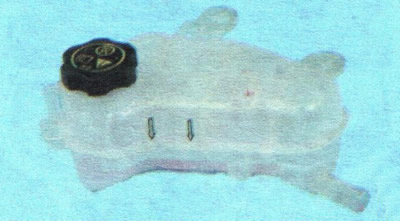
Expansion tank serves to compensate for the changing volume of the coolant depending on its temperature. The tank is made of translucent plastic. Two arrows are applied to its wall to control the level of the coolant, a filler neck is located on top, hermetically sealed with a plastic stopper with two valves inside (inlet and outlet), collected in a single block. The exhaust valve opens at a pressure of 140-150 kPa (1.4-1.5 kgf/cm2), providing an increase in the temperature of the start of boiling of the coolant and preventing intense vaporization. When the liquid is cooled, its volume decreases and a vacuum is created in the system. The inlet valve in the plug opens at a vacuum of about 3 kPa (0.03 kgf/cm2) and lets air into the expansion tank.
NOTE: Plug valves are very important for proper operation of the cooling system, but often when problems occur (boiling of coolant, etc.) motorists pay attention only to the operation of the thermostat, forgetting to check the valves. Leakage of the exhaust valve leads to a decrease in the boiling point of the coolant, and its jamming in the closed state leads to an emergency increase in pressure in the system, which can cause damage to the radiator and hoses.
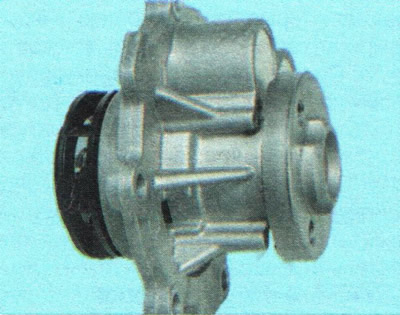
Water pump centrifugal type provides forced circulation of liquid in the cooling system, is installed on the front surface of the cylinder block and is driven by a V-ribbed belt for the auxiliary drive. The pump has sealed bearings that do not require relubrication. The pump is not subject to repair, in case of failure (fluid leakage or bearing damage) it is replaced as an assembly.
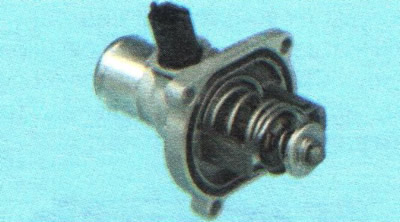
Thermostat with a solid temperature-sensitive filler is installed on the water distributor. The thermostat maintains the normal operating temperature of the coolant and reduces the warm-up time of the engine. An electric heating element is built into the thermostat, which, at the command of the electronic engine control unit, heats up the filler, reducing, if necessary, the thermostat opening temperature.
In the partial load mode, the heating element is not energized, the thermostat is completely closed at a coolant temperature of up to 105°C. In this case, the liquid circulates along a small circuit, bypassing the radiator, which accelerates the engine warm-up. At a temperature of 105°C, the thermostat begins to open, and at 120°C it comes off completely, providing fluid circulation through the radiator.
In full load mode on the engine, the heating element turns on and the temperature at which the thermostat starts to open drops to 90°C.
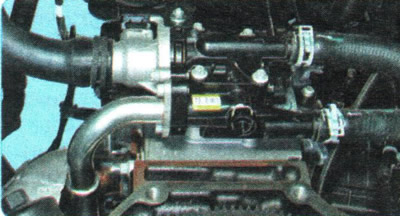
water dispenser, in the plastic case of which the coolant temperature sensor is located, is installed on the rear end of the cylinder head. A water distribution pipe and heater radiator hoses are connected to the water distributor.
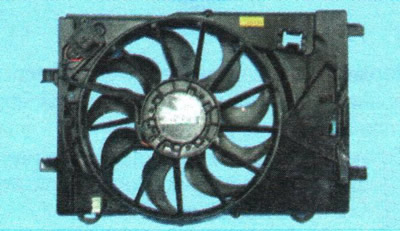
electric fan with a plastic nine-bladed asymmetric impeller, it ensures the radiator is blown with air at low vehicle speeds, mainly in urban areas or on mountain roads, when the oncoming air flow is insufficient to cool the radiator.
To increase the efficiency of work, the fan is installed in the casing and attached to it at three points through rubber cushions. The casing, in turn, is attached to the radiator at four points.
The electric fan is controlled by the engine control unit, which receives information about the coolant temperature from the coolant temperature sensor located in the water distributor.
In addition to the listed elements, the system includes an engine cooling jacket surrounding the cylinder walls in the block, combustion chambers and gas channels in the cylinder head. In addition, the interior heater radiator is included in the cooling system using hoses.
